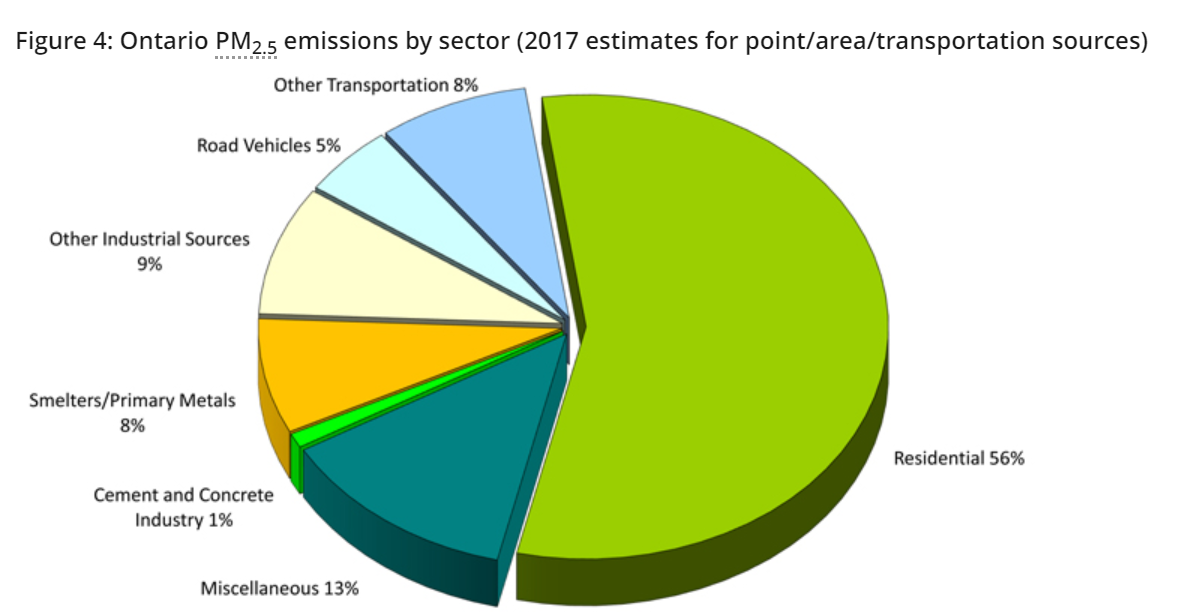Total Suspended Particulate (TSP) refers to all of the liquid and solid airborne particles found in the ambient atmosphere. Particles less than 10 micrometers (microns) in diameter are called PM10, or inhalable particulate matter. These are small enough to be inhaled into the lungs thus posing a significant health risk. Particulates 2.5 micrometers micrometers or less in diameter are called PM2.5 or fine/respirable particulate matter. These particles make up a portion of PM10 and pose the greatest health risk.
Ontario Fine Particulate Matter Emissions by Sector – 2017 Estimates

Acid particles, or acid aerosols, are among the smallest particles comprising PM10. They are generated in the atmosphere when sulphur dioxide (SO2) and nitrogen oxides (NOx) are transformed into sulphuric and nitric acid compounds.
Particulate matter is emitted from point sources: fuel combustion in engines and power plants, waste incineration; and area sources: construction, mining, residential wood burning and road and soil dust. A large part of Ontario’s PM2.5 comes from transboundary emissions in the U.S.
Health Effects
Particles Affect Sensitive Groups
Many studies have shown that particles affect us all. However, certain groups seem more sensitive to particulate pollution. Studies show that children with respiratory symptoms, as well as the elderly, are more susceptible to the effects of PM10. PM10 pollution causes greater increases in mortality among the elderly than in other age groups, as shown by Marzia Simoni1 in a 2015 scientific journal. Certain groups of people have lower thresholds for responding to particulate pollution. These groups should take extra precautions to limit their exposure during high pollution days as identified by Ontario’s AQHI.
Particles reduce lung function and increase mortality
Particles smaller than ten microns (PM10) penetrate deep into our lungs. Here, chemicals ranging from metal compounds to acid droplets react to reduce lung function and produce other effects leading to increased mortality. Pope & Dockery2 published in a 1991 journal article that children suffer temporary reductions in lung capacity during and following higher PM10 days. Public Health Ontario reported in 20133 that increased PM10 was associated with an increased number of deaths. Other studies confirm these findings. The pollutants which make up PM10 represent a serious threat to our health.
Acidic Particles Affect Our Health
Acidic particles represent a distinct health risk. Neas4 and others, in 1995, found an effect of acid aerosols on lung function in children which was independent of other particles. Thurston5 and others documented the role of acid aerosols in Toronto in their 1994 paper. They found that on high pollution days, acidic particles were the pollutants most strongly associated with respiratory admissions to hospitals. Further, sulphate, a type of acidic particle, showed an association with admissions, even when considered separately. Acidic particles are an important component of air pollution with distinct health effects on the population.
More information on fine particulate matter and health is available here.
Did you know?
- London, winter of 1952: A catastrophic one week air pollution episode occurred sending particulate levels soaring and resulting in 3500 excess deaths.
- Provincial PM2.5 emissions decreased approximately 16% from 2008 to 2017
- Diesel engines emit 30 to 100 times more PM10 than gasoline powered engines do
- Particles affect sensitive groups and can cause premature death
What is being done?
Currently, the Ontario Ambient Air Quality Criterion for Total Suspended Particulates (TSP) is 120 micrograms per cubic metre (ug/m3) over 24 hours, and not greater than 60 ug/m3 annually. The Ontario Ambient Air Quality Criteria for PM10 is 50µg/m3 over 24 hours.
Ontario became the first province to introduce PM2.5 to the Air Quality Index in 2002. The Ontario Ambient Air Quality Criterion for PM2.5 is 27 micrograms per cubic metre (ug/m3) over 24 hours, and not greater than 8.8 ug/m3 annually. While these are the standards, it is recommended that decision makers aim for ambient levels of PM2.5 to be no more than 25 µg/m3 (24 hr) at single facilities so that the various airsheds in Ontario are able to reach Canada-wide Standard targets.6
From the mid 1990s to 2017, Hamilton has reduced PM10 by 37% and PM2.5 by 26%.
How can you help?
REDUCE YOUR OWN EMISSIONS: Decrease the amount you drive, and keep your car well tuned; avoid burning wood in your fireplace at home on calm nights.
BE INFORMED: Request information from local government, the Ministry of the Environment, Conservation and Parks, Environment Canada, plant managers and environmental groups. Determine if you’re at increased risk of health problems due to air pollution. Sign up for AQHI alerts with Environment Canada.
BE INVOLVED: Register complaints about air quality with the Ministry of Environment, Conservation and Parks online or at 1-866-663-8477.
6 Ontario’s Ambient Air Quality Criteria, Government of Ontario, https://www.ontario.ca/page/ontarios-ambient-air-quality-criteria-sorted-contaminant-name

